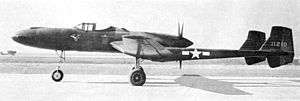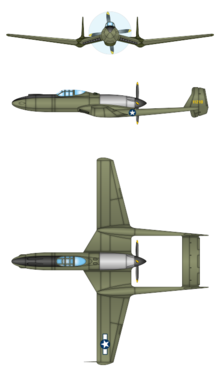Vultee XP-54
The Vultee XP-54 Swoose Goose was a prototype fighter built by the Vultee Aircraft Company for the United States Army Air Forces (USAAF).
| XP-54 | |
|---|---|
 | |
| Role | Fighter |
| National origin | United States |
| Manufacturer | Vultee Aircraft |
| First flight | 15 January 1943 |
| Status | Canceled |
| Primary user | United States Army Air Forces |
| Number built | 2 |
| Variants | XP-68 Tornado |
Design and development
Vultee had submitted a proposal in response to a U.S. Army Air Corps request for an unusual configuration. The Vultee design won the competition, beating the Curtiss XP-55 Ascender and the Northrop XP-56 Black Bullet. Vultee designated it Model 84, a descendant of their earlier Model 78. After completing preliminary engineering and wind tunnel tests, a contract for a prototype was awarded on 8 January 1941. A second prototype was ordered on 17 March 1942. Although it appeared to be a radical design, its actual performance was lackluster and the project was subsequently canceled.
The XP-54 was designed with a pusher engine in the aft part of the fuselage. The tail was mounted rearward between two mid-wing booms, with the 12-ft propeller between them. The design included a "ducted wing section" developed by the NACA that enabled installation of cooling radiators and intercoolers in the inverted gull wing. The Pratt & Whitney X-1800 engine was initially proposed as the powerplant but after its development was discontinued, the liquid-cooled Lycoming XH-2470 was substituted.
In September 1941, the XP-54 mission was changed from low altitude to high altitude interception. Consequently, a turbo-supercharger and heavier armor had to be added, and the estimated empty weight increased from 11,500 to 18,000 lb (5,200 to 8,200 kg).

The XP-54 was unique in numerous ways. The pressurized cockpit required a complex entry system: the pilot's seat acted as an elevator for cockpit access from the ground. The pilot lowered the seat electrically, sat in it, and raised it into the cockpit. Bail-out procedure was complicated by the pressurization system and necessitated a downward ejection of the pilot and seat in order to clear the propeller arc.[1] Also, the nose section could pivot through the vertical, three degrees up and six degrees down. In the nose, two 37 mm T-9 cannon were in rigid mounts while two .50 cal machine guns were in movable mounts. Movement of the nose and machine guns was controlled by a special compensating gun sight. Thus, the cannon trajectory could be elevated without altering the flight attitude of the airplane. The large nose section gave rise to its whimsical nickname, the Swoose Goose, inspired by a song about Alexander who was half swan and half goose: "Alexander was a swoose." – a name also partly shared with the oldest surviving B-17.
Operational history
Flight tests of the first prototype, 41-1210, began on 15 January 1943. Initial trials showed performance to be substantially below guarantees. At the same time, development of the XH-2470 engine was discontinued and, although it appeared possible to substitute the Allison V-3420 engine without substantial airframe changes, the projected delay and costs resulted in a decision not to consider production buys.
The prototypes continued to be used in an experimental program until problems with the Lycoming engines and lack of spare parts caused termination. The second prototype, 42-108994 (but mistakenly painted as 42-1211) equipped with an experimental GE supercharger, made 10 flights before it was relegated to a "parts plane" in order to keep the first prototype in the air.[2][3]
Specifications (XP-54)

Data from Green and Swanborough 1978, p. 84.
General characteristics
- Crew: one, pilot
- Length: 54 ft 9 in (16.69 m)
- Wingspan: 53 ft 10 in (16.41 m)
- Height: 14 ft 6 in (4.42 m)
- Wing area: 456 sq ft (42.4 m2)
- Empty weight: 15,262 lb (6,923 kg)
- Gross weight: 18,233 lb (8,270 kg)
- Max takeoff weight: 19,337 lb (8,771 kg)
- Powerplant: 1 × Lycoming XH-2470-1 liquid-cooled piston engine, 2,300 shp (1,715 kW)
Performance
- Maximum speed: 381 mph (613 km/h, 331 kn) at 28,500 ft (8,700 m)
- Range: 500 mi (805 km, 430 nmi)
- Service ceiling: 37,000 ft (11,300 m)
- Rate of climb: 2,300 ft/min (11.7 m/s)
- Wing loading: 40 lb/sq ft (196 kg/m2)
- Power/mass: 0.13 hp/lb (0.20 kW/kg)
Armament
- 2 × 37 mm T-12/T-13 cannon 100 rds
- 2 × .50 cal M2 Browning machine guns 580 rds
See also
Related development
Aircraft of comparable role, configuration and era
Related lists
References
- Notes
- Thompson 1992, p. 118.
- Thompson 1992, p. 114.
- Balzer, Gerald H. American Secret Pusher Fighters of World War II: XP-54, XP-55, and XP-56. North Branch, Minnesota: Specialty Press, 2008. ISBN 1-58007-125-2.
- Bibliography
- Balzer, Gerald H. American Secret Pusher Fighters of World War II: XP-54, XP-55, and XP-56. North Branch, Minnesota: Specialty Press, 2008. ISBN 1-58007-125-2.
- Green, William. War Planes of the Second World War, Volume Four: Fighters. London: MacDonald & Co. (Publishers) Ltd., 1961 (Sixth impression 1969). ISBN 0-356-01448-7.
- Green, William and Gordon Swanborough. WW2 Aircraft Fact Files: US Army Air Force Fighters, Part 2. London: Macdonald and Jane's Publishers Ltd., 1978. ISBN 0-354-01072-7.
- Jenkins, Dennis R. and Tony R. Landis. Experimental & Prototype U.S. Air Force Jet Fighters. North Branch, Minnesota: Specialty Press, 2008. ISBN 978-1-58007-111-6.
- Thompson, Jonathan. Vultee Aircraft 1932–1947. Santa Ana, CA: Narkiewicz/Thompson, 1992. ISBN 0-913322-02-4.
External links
| Wikimedia Commons has media related to Vultee XP-54. |